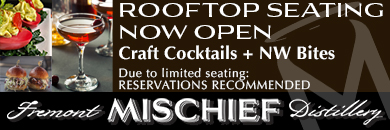an editorial by Kirby Lindsay, posted 13 July 2011

As Fremont has grown and developed over the last three decades, more opportunities exist for those who want to help preserve, maintain and/or improve our community. Even as the ‘hood has gotten better (in my opinion) the ways to pitch in to help have expanded.
Three established community organizations remain our primary method for new volunteers to plug in to this neighborhood. The Fremont Chamber of Commerce (FCC) represents the interests of businesses and entrepreneurs, the Fremont Neighborhood Council (FNC) represents residential concerns, and the Fremont Arts Council (FAC) represents those with interests in the arts and FAC events.
Open the Door
All three groups welcome new attendees to their monthly meetings, regardless of membership status. They’d like people to join, but they welcome observation by the general public. Attendees can comment, and influence, discussions at these meetings, although with respect to any pre-arranged agenda that may be in play.
This open door policy makes sense in a small neighborhood like Fremont. This open invitation also has historic precedence, as both the FAC and FNC began as City of Seattle programs that demanded inclusivity.
Yet, visitors attending in the last two years may have witnessed moments that gave an appearance of secrecy and backroom dealings. All three groups have taken to deferring some decisions – and discussions – to smaller, sub-groups of the organization, away from public view.

The FNC holds ‘Executive Sessions’ of their Board of Directors, usually immediately following their monthly meeting. The FCC calls theirs the Oversight Committee or Executive Committee, which meets on the Tuesday the week before the monthly Board meeting and consists of certain, publicly unidentified Board Members. The FAC defers many decisions, and discussions, to the Board of Directors who meet at random times and locations rarely identified publicly.
For The Good
The need for quick, informed decisions may be the reason behind the use of these small, informed groups. A public meeting model requires endless review, and repetitive discussions that can prove ineffective. The Chamber has a Board of over 20 members; a cumbersome crowd for detailed debates. The FAC operates under a consensus model, which requires all meeting attendees be allowed a voice for their concerns – another cumbersome process.
Another reason for these apparently closed door meetings might be secrecy. The FNC has filed lawsuits over the year, and discussion and consultation with lawyers cannot be done with public scrutiny.

Finally, these smaller, focused groups can meet, and take immediate action, at a moment of crisis. An established committee can trade a few phone calls (or e-mails) to reach a decision, and avoid the need to consult each member of the larger body. (A great case in point would be the current effort by the FAC to revise their by-laws, and the difficulty they’ve had in turning out their entire membership to vote.) A smaller committee can provide a measure of safety to deal with severe situations, but only after the larger organization has empowered them to decide on behalf of the group.
For The Bad
The perception that these sub-groups act in secret, without authority and distributing autocratic dictates, is rarely reality. The brief dismissal of a topic at a meeting as one for another group – some other time, at some other place – can make a visitor feel unwelcome, and unnecessary to the process.
Particularly because discussions do require input, and not just from those ‘on the inside’ or ‘in the know.’ A variety of people who bring a variety of perspectives, resources and experiences must participate. If the same people keep making decisions, the creativity, innovation and cutting-edge-peculiarity that resurrected Fremont in the 1980s will suffer.

Transparency in government has transformed into a cliché since the 2008 Federal election, but it is still a valid goal. A small community must require transparency, and even a perception by prospective members that they are outsiders.
Step Inside
It may take newbies, speaking up and suppressing the Seattle-nice urges, to demand to know what is going on and an opening of the door to the backroom. To get involved, and participate in that transparency, attend one of the three meetings.
The Fremont Neighborhood Council meets on the fourth Monday of each month, at 7p, in the back conference room at History House (although that location may change soon.)
The Fremont Chamber holds their meeting for neighborhood topics on the last Wednesday of the month, at 8a, also in the back conference room of History House.
The Fremont Arts Council holds their monthly ‘Committee of the Whole’ meetings on the second Tuesday of the month, starting at 7:10p-ish, in their headquarters at the Powerhouse (3920 Fremont Avenue North.)
These dates and times can always be found on the Fremocentrist.com community calendar – or on the organization’s own websites. Remember, the best way to help is to get involved!
Related Articles
- Step Inside The Closed Doors
- by Kirby Lindsay, November 2006 for Fremont.com
- The Anti-Anarchist’s Guide To Fomenting Revolt And Overthrowing A Community Organization
- by Kirby Lindsay, November 29, 2006 in the North Seattle Herald-Outlook
- FAC Highlight Reel: What Else Is There?
- by Kirby Lindsay, June 17, 2011
©2011 Kirby Lindsay. This column is protected by intellectual property laws, including U.S. copyright laws. Reproduction, adaptation or distribution without permission is prohibited.

